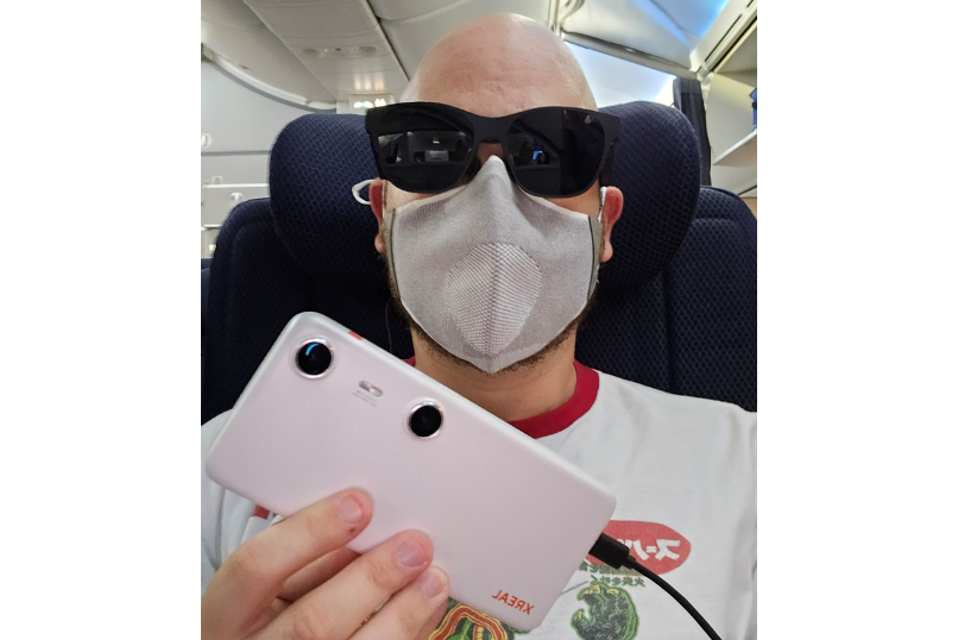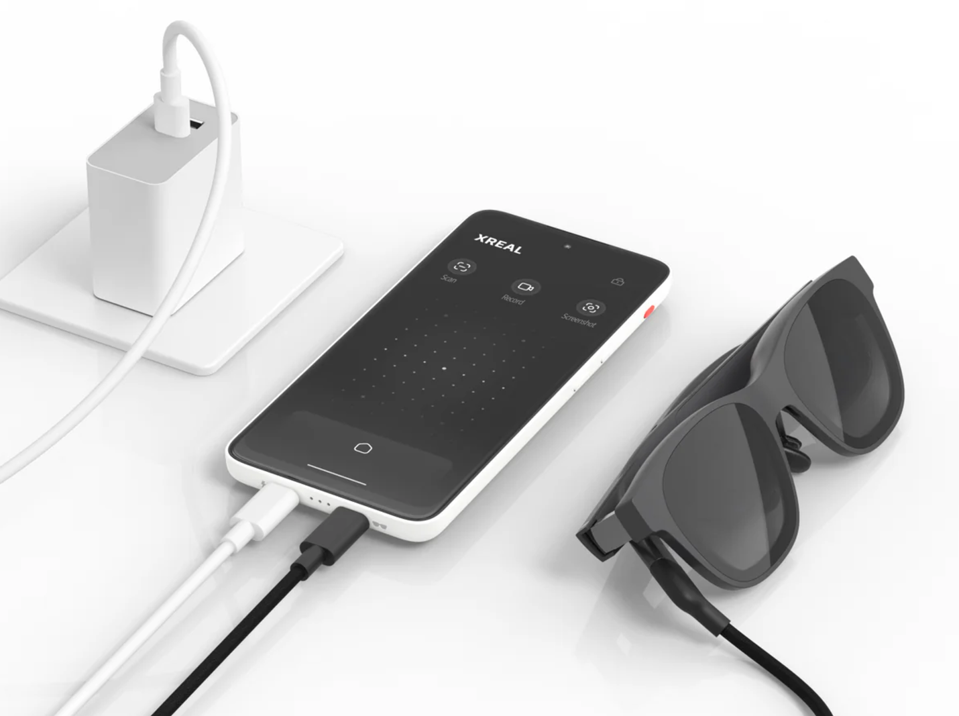
Thanks to a test unit shared by the team at Xreal, I have spent the last few months dragging the Xreal Beam Pro handheld device and Air 2 Pro glasses along on my work travels. Xreal recently published a statistic that says the company has shipped the most AR headsets on the market, north of 400,000 units. That number—which is extremely small compared to, say, smartphones shipped by any significant maker—shows how nascent the AR market is. It’s also a reminder that Xreal (formerly nReal) has been around for a long time since it debuted with the complex and ambitious 6-degree-of-freedom design of the nReal Light glasses.
Since then, the company has dialed back the vision a bit and tried to first nail the 3-DoF experience by using an AR head-mounted display that allows for virtual 2-D screens. In my opinion, of all the comparable products on the market, Xreal’s glasses have been the most reliable and easiest to pair with Android or iOS devices, as well as the best for leveling up the gaming experience on devices like a Switch or Steam Deck. The plug-and-play nature of Xreal’s glasses has made them invaluable for improving mobile experiences or even mirroring as a second display on a laptop; I have done the latter with multiple Windows PCs, including some of the new Copilot+ PCs.
Xreal Beam Pro — Better Than A Phone Or Tablet For AR
Before the Beam Pro handheld device, there was the Beam. The Beam’s job was to help connect third-party devices to the Xreal glasses to create a seamless experience, since not all devices can support the glasses natively and not all of them can render the virtual screen. Beam Pro builds on Beam’s capabilities—and levels them up considerably—by adding the full feature set of an Android device that can run all your streaming and Android gaming apps. It also allows you to add extra storage via a memory card to preload movies and TV shows without using up storage on your phone. The device comes with two USB-C ports, one for the glasses and one for power, so you can keep running it in perpetuity—for example if you’re on a long flight.
When connected to Xreal AR glasses, the Beam Pro also acts as a touch controller for AR interfaces and a keyboard when you need to input text. The Beam Pro also has a pair of 50 MP cameras that are perfectly distanced from each other to mimic the distance between human eyes for 3-D photos and video. Most of the images I’ve captured look tremendous and build a sense of immersion that is hard to convey without seeing them in person. The fact that the Beam Pro has so many different capabilities drives up its value.

Additionally, the Beam Pro spares you from drawing down your smartphone battery to watch TV or movies on the go. At $199, the Beam Pro is very reasonably priced, and it now accompanies my Air 2 Pro glasses anywhere I travel. (It works great with any of Xreal’s AR glasses.) This combination is also much more compact and accessible to transport than the Apple Vision Pro, even though I do think the Vision Pro has the absolute best TV and movie experience. I also have the option of leaving the Beam Pro at home and connecting the Air 2 Pro glasses to my phone. There are still some software stability issues with the Beam Pro; for instance, there have been many instances when I have wanted to show off a 3-D photo or video I’ve taken with the Beam Pro on the Air 2 Pro glasses, but the entire Nebula interface has crashed. Nebula is Xreal’s operating system for AR applications and the interface for spatial apps including the 2-D windows in 3-D space.
My biggest complaint about the Beam Pro is a broader problem for the AR industry: there aren’t enough AR apps to make 3-D AR experiences particularly exciting. This is why I believe that Xreal has opted to deliver the most basic AR experience with a 3-DoF 2-D display. I do believe that Xreal wants to move towards more 6-DoF experiences; after all, the company has Air 2 Ultra AR glasses that could potentially enable that, but there aren’t many apps that could take advantage of it. I have a feeling that Google’s upcoming XR platform may help solve this problem by enabling more AR apps across the many different AR platforms that exist today.
Air 2 Pro Glasses — High Definition, Limited Field Of View
The Air 2 Pro glasses are a noticeable improvement over the Xreal Air glasses I had previously tested. Xreal has improved the weight—now only 75g—and incorporated a 500-nit, 120-hertz 1080P micro-OLED panel from Sony. The brightness and image quality are much improved, and the ability to dim the glasses with a simple button push was really enjoyable. I haven’t used these glasses much outdoors, and they aren’t really intended for that since you can’t really move around without 6-DoF tracking. The 46-degree field of view leaves me wanting more, although the Beam Pro does helps to maximize the experience through software. For true AR experiences, though, I could see this field of view being challenging.
I have mostly used the Air 2 Pros on planes and in hotel rooms while traveling, and they have worked great for that purpose. I had no issues running them on the Xreal Beam Pro, iPhone 15 Pro Max, iPhone 16 or my Galaxy S24 Ultra. While I do wish they had a wider field of view, they are limited by the birdbath optics that help keep them affordable. These glasses are currently selling on Amazon and the Xreal website for $399, and there are occasional bundle deals as well. I think they are fairly priced for what they deliver, although I do believe that if Xreal could get them down to $299, they would move a lot more units.
The Next Phase Of AR
Xreal has been teasing an in-house-designed X1 chip and a new product based on it, and while I don’t have any details about what that product might be, there are a lot of ways Xreal could go. There could be the addition of 6-DoF for true AR experiences, hand-tracking for more natural interfaces or even a standalone solution that doesn’t require a smartphone or any kind of computer at all. I believe the latter to be a bit of a stretch since I know Xreal isn’t in the business of making its own SoCs. After all, the Beam Pro uses a Snapdragon processor.
This reminds me that I do think we’ll see Xreal included in Google’s XR platform announcement whenever it happens later this year, given Google’s relationship with Qualcomm. It’s clear that Samsung will own the standalone category with the MR headset it is building with Google and Qualcomm, but I believe that Google also wants another crack at AR. Partnering with Xreal could be one of the best ways for Google to attack that category and do it effectively.























































































